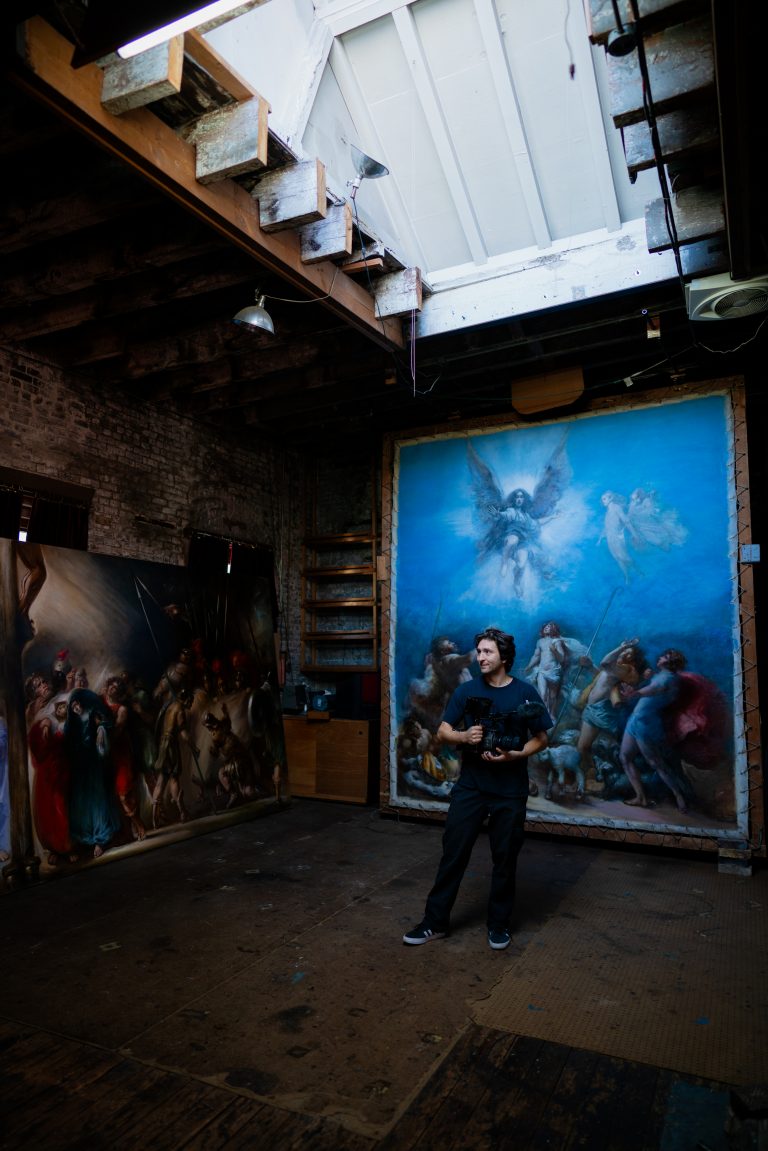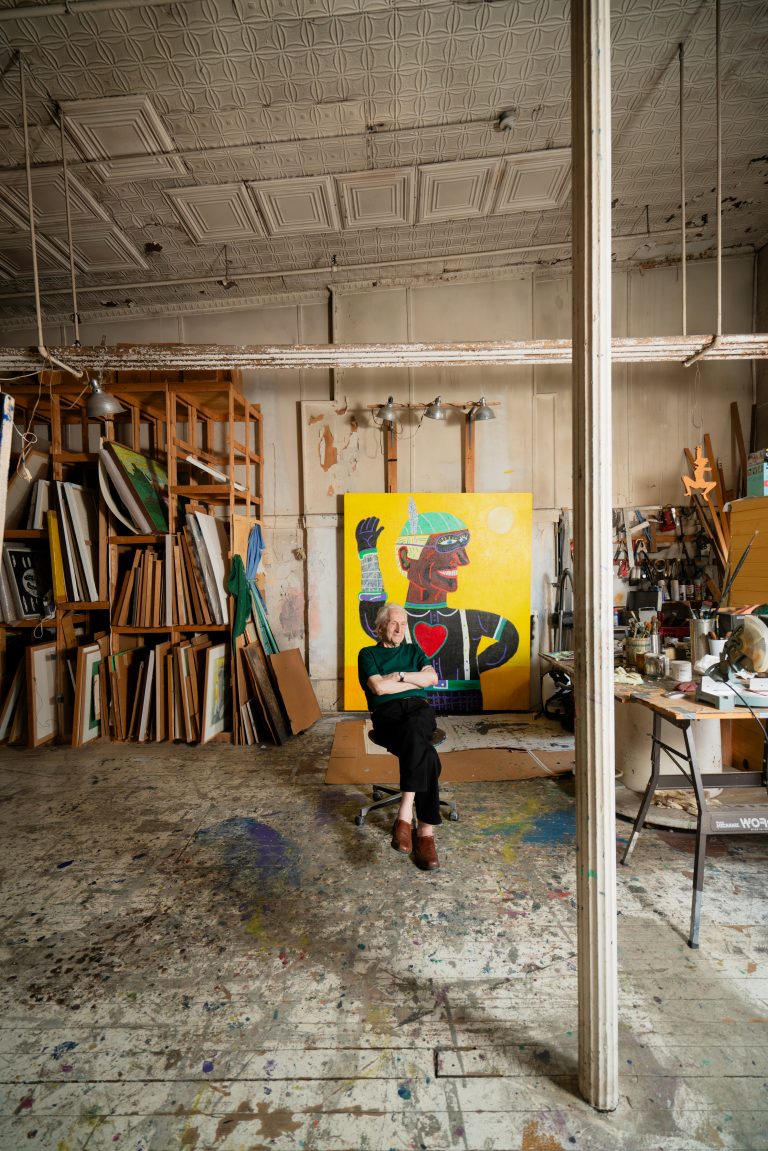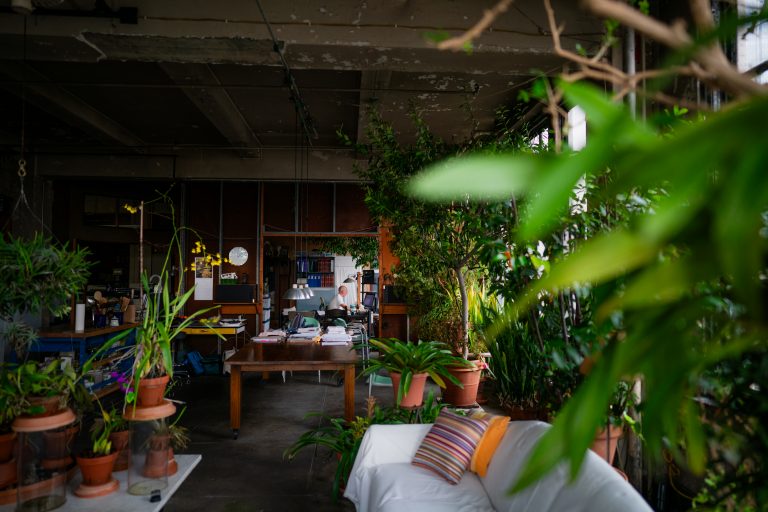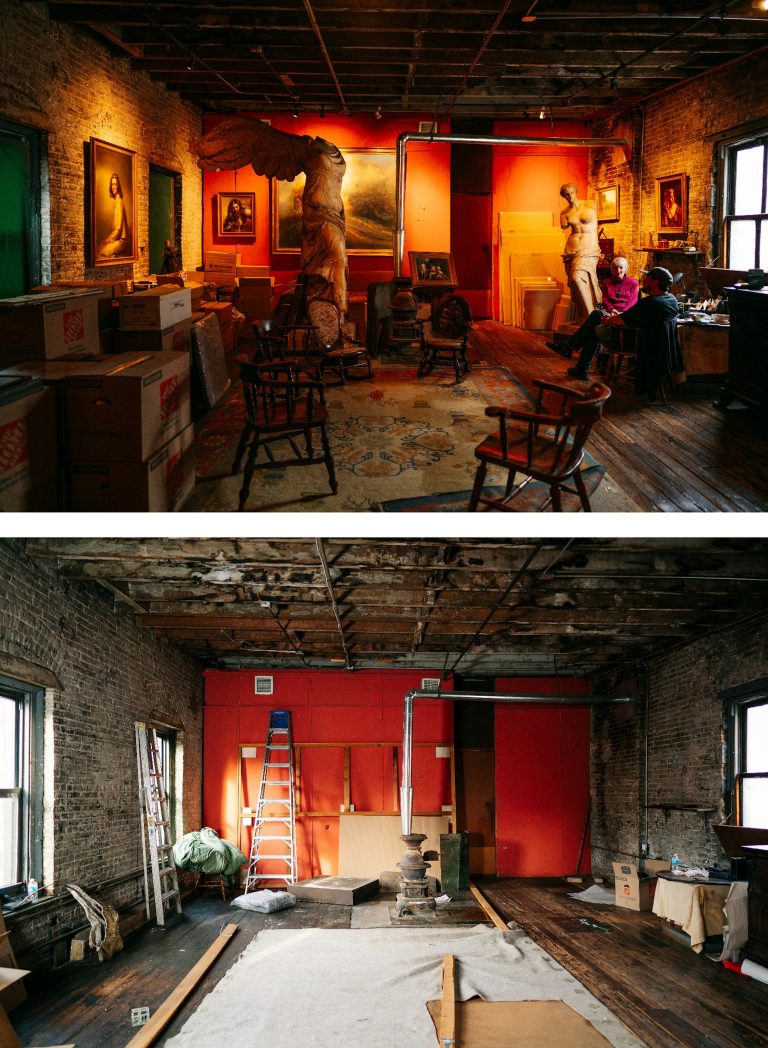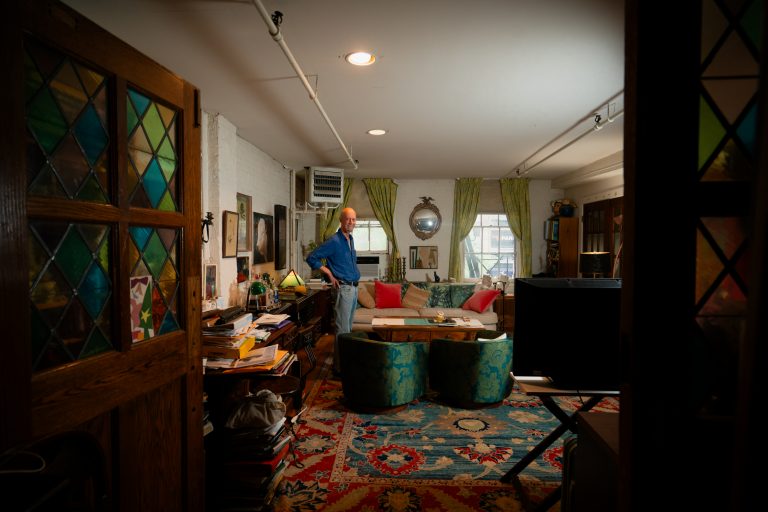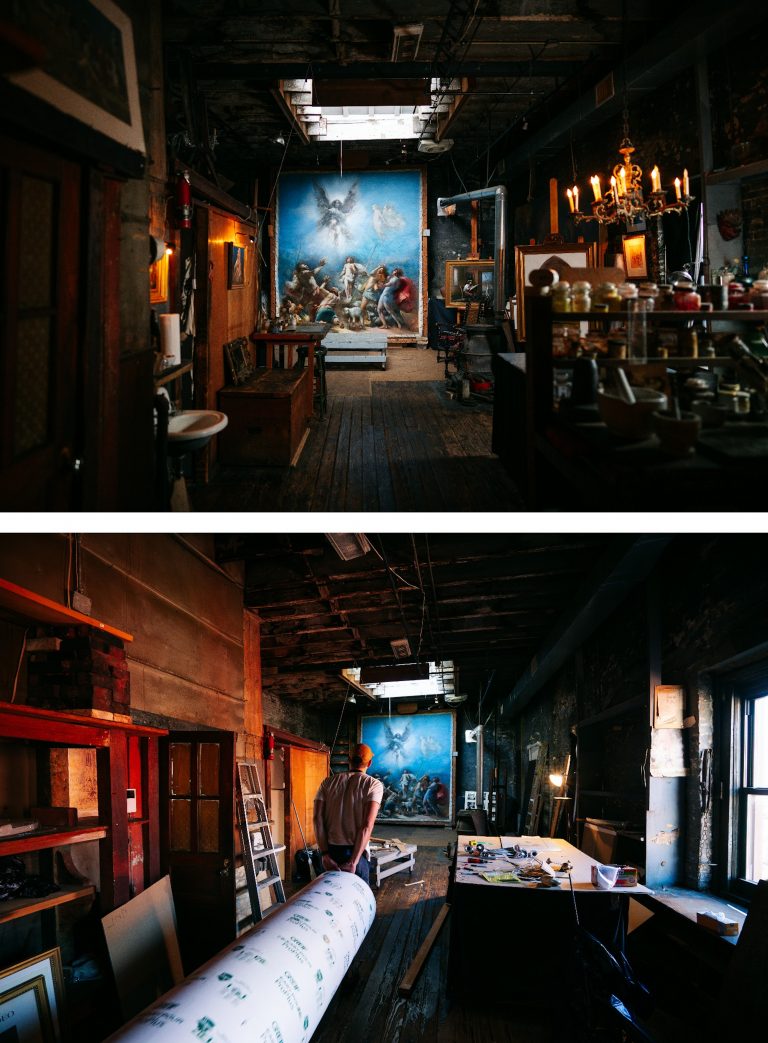Joshua Charow unveils the remaining spaces that helped foster New York City’s epicentral art world reputation

Scott Mason September 7, 2024
(All photography in this article courtesy of Joshua Charow.)
Joshua Charow used to jump from roof to roof to photograph New York City street scenes but it wasn’t until he stumbled into the protected habitats of NYC artists that he discovered a world of overlooked beauty. What began as a curiosity quickly developed into an obsession that has spanned three years and which has led to a photography book, Loft Law: The Last of New York City’s Original Artist Lofts (pub: Damiani Books) and a series of short documentaries that can be found on his instagram @joshuacharow.
Joshua Charow in Anne Mason’s Little Italy loft space. Murals by Frank Mason (1921-2009): Crucifixion (left) and Gloria in Excelsis Deo (right). Photo: Josh Curley.
Loft Law: The Last of New York City’s Original Artist Lofts is a tribute to the once affordable, now highly coveted, spaces in some of the city’s most desirable neighborhoods. Spacious live / work environments that would have surely been swept up in the money fever of urban development if not for a small group of activists with legal chutzpah. As one protected Loft Law tenant, turned legal expert, puts it, “People who are protected by the Loft Law belong in New York City, and they’re the real heart and soul of the city.”
In the ArtWatch interview, which took place over Zoom, Charow recounts his great joy listening to the stories of tried-and-true Gotham artists while explaining the legal actions required to protect these magical places.
Scott: As a photographer and a journalist what immediately struck you when you started to enter these unique loft spaces?
Joshua: The very first one that I got to photograph was Carmen Cicero, who at the time when I met him, was 94 and he was living on the top floor of a loft on the Bowery and he had these huge 6- to 8-foot-long paintings, and he had super tall tin ceilings and painted white wooden floors where the paint splattered. You could tell he had been living there for decades and it was better than the movies. His stories were incredible.
Carmen Cicero in his fifth-floor walkup loft on the Bowery.
He was in the first show at Frank Lloyd Wright’s Guggenheim, and I was immediately captured by his personality, his space, and the world that he created in his studio. And so, it just broke all these misconceptions I had of what’s possible in New York today. And while it’s true these people have been grandfathered in, it became a mission of mine to capture the spaces and the artists while they’re still part of the city, because getting to meet and spend time with all these people has truly been one of the best adventures and honors and joys of my life. I do really, really think that it’s an important thing for the city to have and it terrifies me that decades from now, there’s going to be very, very few of these spaces left.
Scott: You’re capturing the setting sun of these people’s prolific careers and lives. The stories that they tell are much different from those from emerging artists. Yet you yourself are an emerging artist.
Carolyn Oberst and Jeff Way in their Tribeca loft.
Joshua: A lot of artists when I first came into their lofts and photographed them said, I don’t think anyone will care about this. I don’t understand why you’re interested in these spaces or us. To me, I was baffled because this was the most interesting thing I’d ever come across. And I would imagine part of that is this intergenerational crossover in that Carolyn Oberst and Jeff Way, who are two fantastic painters who lived in Tribeca since 1975, they said this is just what everyone did in the 70s. Everyone had lofts like this. This isn’t anything unique. But, you know, when I moved to New York eight years ago, in my generation, no, I don’t know a single person who lives in a space like this or makes paintings like they do. So, I think the fact that we’re coming from different generations is what allowed this interest to bubble up in me.
Bob Petrucci, legal activist working in his midtown Manhattan loft.
Scott: Legal activist and loft law resident, Bob Petrucci, pointed out, “People who are protected by the Loft Law belong in New York City, and they’re the real heart and soul of the city.” What do you think he meant by that?
Joshua: The way someone described this to me that I absolutely love is if you’re visiting New York and you go sit down at a bar, who is the person that you want to meet next to you? And to me, it’s Carmen Cicero, it’s Anne Mason. It’s someone who has been deeply embedded in the cultural life of New York City for their entire life, who has these incredible stories and experiences and makes art and lives in an old factory. I mean, this is so fantastical, and it’s hard for me to even explain what makes it interesting because everything about it is interesting. I feel like my own life has been enriched and my perspective has widened from meeting all these artists, and I can only imagine how much of an effect they’ve had on the greater city as a whole, if they’ve made such an impact on just one person, me. All these people have such wide impact on the people they come across in their life in New York and they should be here. They are the lifeblood of the city.
Scott: Jennifer Charles, to quote another passage in your book, said “We’re an endangered breed, being an artist in New York.” Why was this project important to you as both an artist and, can we call you a preservationist in a way?
Joshua: I want to create and capture something that might not be around in ten years or 20 years or 30 years. That’s really a thread that runs through all of the films and photographs that I make. And so, will there always be artists in New York? I hope so. I believe so, I think it looks different if you’re a young artist moving to New York now. You probably have a lot of roommates and a very small room. And maybe you make your art on your computer…
Jennifer Charles in her Greenpoint loft, “We’re an endangered breed, being an artist in New York.”
…But this culture is what New York became famous for in the art world. This New York was the epicenter of the art world in the 60s and 70s. I wanted to capture it before it’s gone. I photographed multiple people who left, but yours was the only one that I saw empty compared to when I saw it filled with art. And you just see the life get sucked out of it. And unfortunately, that will be the fate for many of these other spaces I photographed.
Mason studio in Lower Manhattan with plaster cast copies of Greek sculptures before and after moving out.
Scott: What was perhaps the most valuable lesson you learned from meeting with all these dedicated and passionate artists?
Joshua: Getting to speak to an artist in their 90s you learn about the ebbs and flows of being an artist throughout your life and the good periods and the bad periods. And it’s made me have a bit more patience and have more perspective and take a longer look at how I want to approach what I create over my life.
Scott: Robert Frost said, “If you’re looking for something to be brave about, consider the fine arts”, which speaks volumes about how difficult it can be to succeed as an artist. And many of the artists you interview mentioned this in various ways. What keeps the artists so disciplined to try to maintain and preserve these types of spaces?
Chuck Delaney, founding member of the Lower Manhattan Loft Tenants.
Joshua: I asked Chuck Delaney about this, who was one of the founders of the Lower Manhattan loft tenants. I asked him why the majority are artists in these spaces, because what I found interesting was that the Loft Law, which protected most of the artists in the book, did not say you had to be an artist to qualify. All you had to do was be illegally living in one of these commercial and manufacturing zoned spaces. So, I think back in the 60s and 70s, right, these were completely raw spaces. For the people who were moving in for the first time after manufacturing had left, they didn’t have kitchens, they didn’t have showers. And so it took someone who was willing to rent a raw space who might have been crafty enough to install their own plumbing and electric. Someone who would want a huge space with tall ceilings, who would need big windows. And back in the 60s and 70s art was so big. So, just because of the nature of these spaces and because there were no manufacturing tenants on the horizon, artists seemed to be the biggest population that would actually want to pay money for these spaces. But to do this style of living, you needed a reason for it in your life and it seems like the only people that really had the reason were artists.
Scott: How has this mindset changed in our modern day in terms of spaces and how we use them?
Joshua: To me now, getting a space, especially in New York, is just whatever you can get for the best price you can get it for. And it’s a battle and it wasn’t always like that, right.
Curtis Mitchell in his Dumbo, Brooklyn loft space which was previously an ice cream factory.
There was one artist I spoke to who lives in Dumbo in an ice cream factory, and he said that, “I had complete freedom of whatever I wanted. And I spent a year looking, and I didn’t choose until I came here because this was perfect. I had never seen windows like this. This is exactly what I needed for myself.”
And so, these spaces really do have magical qualities, right? The ice cream factory has 36-foot ceilings, which is higher than I’ve ever seen in a residential space. Frank (Mason’s) studio had the north facing skylight, which gave you that beautiful soft light. And the raindrops were hitting it when I first came up.
I think as an artist, there are these dreams that you have of the conversation you can have between your work and your space, whether that’s from the windows, whether it’s from the high ceilings, the wood floors. And many artists that I interviewed do feel like they’ve built a relationship with these details in their lofts and studios. I wish we could have that now, but it’s just unless you’re rich, very, very rich, it’s not possible. Or unless you’re grandfathered in.
Scott: Is this the last generation of loft law protection for artists’ spaces?
Joshua: My conversations with the lawyers, they thought that there’s probably not going to be another ‘window of coverage’ and that’s what they call it. The first one was 1981 to 1982, and the last one was 2015 to 2016 to say, this is the year that I was living illegally in a commercially zoned space, the landlord knew about it, and there were three or more lofts in the building doing the same thing. Those are the qualifications that you needed, and you need those window periods in order to get coverage. And there’s likely to not be another window period. That’s mostly because the loft laws are reactionary law, and this phenomenon has stopped. All of this space has become so valuable that it’s either been bought up by developers and brought to residential code the legal way, and turned into luxury lofts, very expensive luxury lofts. Or they found commercial tenants and the buildings have just gone back to their original purpose.
So, the reason why it probably won’t extend is because landlords are no longer illegally renting manufacturing space to tenants to live in. That phenomenon has just stopped due to this increased demand in luxury lofts and in commercial spaces again.
I don’t think there is a future for newcomers, but there are buildings that are applying retroactively for the loft law right now. There are people in Brooklyn and the Bronx who do meet the standards but are currently going through the process of getting coverage during these last window periods so they can stay, and it will continue to protect the people who gain coverage under it, which I think is a great thing. And it can also be passed down to a child or a spouse. So hopefully it continues as long as possible.
Scott: ArtWatch’s mission is to act as a watchdog organization in the arena of cultural policy, protecting works of art and public interest from vested, private, and institutional interests. Is there anything through your Loft Law project that you believe aligns with this mission of ArtWatch and how there’ve been a group of people who are trying to protect these living, working spaces that are artwork in their own right?
Joshua: It was the result of a small group of very dedicated, very hard-working individuals in the late 1970s and early 1980s who made this possible. These people really dedicated their lives for a few years to passing this legislation, which then helped thousands of other artists. It’s really surreal talking to them because my project would not exist without them. A lot of the artwork that I got to photograph would probably not exist without them, because if these artists weren’t able to stay in their spaces with 14-foot ceilings, then the huge paintings also wouldn’t have been created and this part of the city might be gone.
Scott: How important was it that these activists were able to preserve these spaces to the point where they exist today?
Joshua: This is probably one of the best policies New York has ever passed for protecting artists. And there’s nothing in it that says you have to be an artist so it’s quite unique in that it protected and kept thousands of artists in New York City over decades, almost by accident on the city’s part – not on the loft tenants. They knew what they were doing, but I think it’s sort of a beautiful thing that happened. People have come into the gallery and told me that, “my city used to have so many of these spaces, and there was just nothing protecting them. And because of that, they’re gone now.” So, I think it’s great that New York passed this law that did help so many people. It still does.
Scott: What makes these previously ordinary spaces worth documenting is something I’m interested in and how that perspective has changed over time, and how space is so coveted now that everybody’s living in shoeboxes. What makes these spaces beautiful now compared to when they were considered undesirable, when they were industrial spaces?
Joshua: The most important reason why these spaces are beautiful or interesting and unique is because of the artists that have lived in them. If Frank didn’t live in that loft, there would not be an enormous, slanted skylight above the space. There would not be a 12-foot mural underneath the skylight glowing from that light. Honestly, I’ve spoken about Frank’s loft because I got to see what it looked like when there was art in it, and I got to see what it looked like after there wasn’t.
Frank Mason’s mural Gloria in Excelsis Deo removed from the Little Italy art studio where it was painted in 1973.
While there is still beauty in these architectural details – like, one of the interesting parts about the project is that whatever year you moved in, the architecture has been preserved from that time, unless you renovated it yourself, right? The landlord has no reason to go in and replace the floors or the ceiling. So, you do get to see the original state of a lot of these buildings. You get the original wooden floors, you get the original patchwork tin ceiling and the columns, the brick walls, which is very interesting. But without the modifications, without the art, without the configurations of the spaces that the artists have created, the magic is gone. The life is gone. It’s interesting seeing architecture, but without the artists, there’s no book. This project doesn’t exist. I like to really push that, you know. There are still some spaces like this that have been converted into luxury lofts, and you still get those architectural details, but they’re so much less interesting.
A unique thing about the Loft Law was that every tenant that I photographed was a renter. So any modification or change they made was not to increase the value of their apartment or their studio. Any modification they made was just to optimize their own life, optimize the way they create their artwork. And so because of that, you get all these incredible modifications, like a skylight that someone cut out of a ceiling
Jeff Way had rented the building after it was in a fire, and he left one of the burnt walls. He juxtaposes his vibrant, colourful masks against a burnt out wall that was from the 1970s when he moved in. And so, because there’s no financial incentive here to bring things into the modern world, you get all these funky, unique, beautiful ideas in the spaces that are very interesting.
Scott: What I loved about coming up to Frank’s studio for the first time when I moved to New York to start studying with him, was that there’s so much artwork that was his own. Whereas, say, someone has one of these beautiful Soho loft spaces and you see Ikea furniture, vases, and it’s just an assembly of everything that might represent their tastes and what they like, but doesn’t necessarily reflect their personal lives or creativity through decades of living in that same space. That’s something very powerful about your book. You capture it very well. Showing these people living in these kinds of capsules that represent themselves through their creative endeavors. And my hat’s off to you for being able to show that in such a very rich, vibrant, creative way, which leads me to my last question. When you first started on this path, doing this project, did you anticipate that your book and the ancillary short documentaries – are you surprised about the type of attention that they’ve garnered?
Joshua: Before I answer this, the last thing you said about artists and having their own work on the wall… I loved at the end of the documentary (A Light in the Dark: The Art and Life of Frank Mason), I got emotional hearing that Frank and Anne were like a living work of art. Beyond his paintings, it’s like their life became a work of art. And that is how I feel going into these spaces. I would imagine you feel the same way that Frank’s loft became a part of his story, and a part of who he is as an artist in such a deep way. When you spend decades there and your walls are covered in what you’ve created, it’s like it’s a reflection of yourself. It’s like a mirror of these lofts. That part was so beautiful in the film.
Scott: Thanks.
Joshua: Okay, I thought this was the most interesting thing in the universe while I was doing it for years. I was shocked that no one had done a project like it because of how amazing these spaces and these artists and these stories were. So, I’m not entirely shocked that others agree, but I am definitely shocked at how many people agree. You can never predict how people will react to something you put your time into and I’m happy that people are connecting with these stories and these spaces. And, you know, it speaks to the power of the artists and the work they create and the lives they’ve lived. I’m always a person who’s valued storytelling over aesthetics. I really tried to make this project about telling the stories and about the humans behind these spaces. I think that’s what’s cutting through and connecting with people.
I’ve spent a lot of time thinking about the reasons why people have connected with this and it’s all guesswork. But there are a few reasons that I can think of. I think for younger generations, like myself, this part of New York City has gained this mythical status and it feels like a fantasy. It feels like it’s something you never knew about. Something you’ve always maybe wondered but didn’t know was still all around you. So, in that way, I think it’s appealing to younger generations.
To a lot of older generations, people have sent me emails and messages from all over the place who experienced this same phenomenon in whatever city they lived in. So Berlin, Sydney, people who lived in a chocolate factory, who were sculptors or just all sorts of unique tales. Like what happened in New York but in places around the world as manufacturing left different metropolitan areas. I think it’s connected with a lot of people in that they see their own youth in this story, because this is what they lived, and they’re delighted to see that there are still artists in these spaces today.
That’s how I’ve been breaking it down – why people are interested. And at the end of the day, I think we’re all captured by a good story and all of these artists are such good storytellers. Like, you can really get roped in. I would listen for hours on end just hearing all of the experiences they’ve had. I mean, having a party for Salvador Dali, it’s like . . .
Scott: It baffles me when we did the documentary, that nobody took a single picture in the studio that night with Salvador Dali running around in his cape and all these interesting socialites in that space at one time. But that’s what it was back then. Nobody had a cell phone, right?
Joshua: Yeah. History can be exciting. And these artists have unintentionally become historians of the art world in New York City. And so, for someone who didn’t have a background in it, I have now learned the art history of New York City through my relationships with these artists. And I think hopefully that’s what’s happening to people who are finding it online or seeing the book.
Weirdly enough, I have photographed two people in the last month who are leaving, and I have two more that are leaving in August that I need to photograph. So, this does feel like some strange point in time where there are people deciding or having to leave after decades. Beyond it being a great joy and fun, I do think it is important to do it.
Scott Mason packing Frank Mason’s artwork in Anne Mason’s Little Italy, NYC studio.
Scott Mason is a NYC artist and filmmaker. He produced the feature length bio-doc, A Light in the Dark: The Art and Life of Frank Mason about his great uncle and mentor, painter Frank Mason, in collaboration with director Sonny Quinn. The artwork of Frank Mason can be found at: https://frankmason.org/.
Loft Law: The Last of New York City’s Original Artist Lofts published by Daniel Books can be purchased at https://www.joshuacharow.com/book/loftlaw

